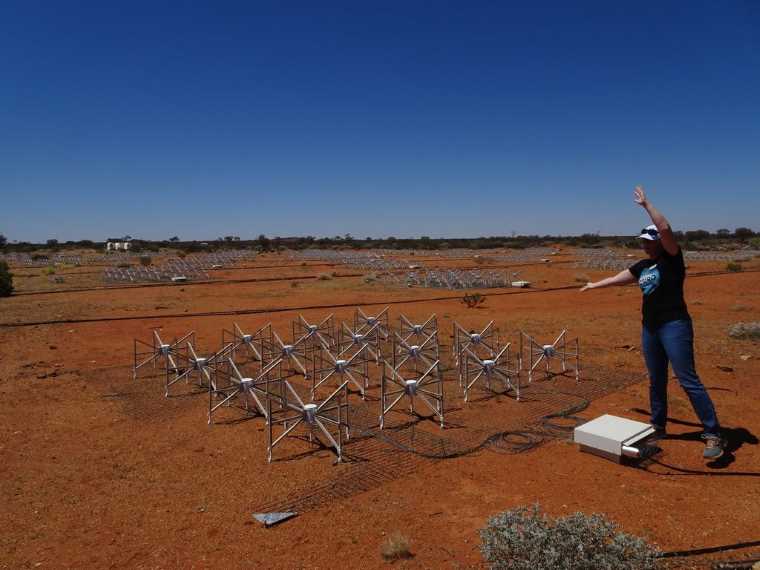Researchers from the SETI Institute, the Berkeley SETI Research Center, and the International Centre for Radio Astronomy Research have announced a potentially groundbreaking study of over 2,800 distant galaxies for signs of highly advanced “super civilizations.” Unlike previous efforts by SETI researchers that scanned our local Milky Way galaxy for signs of advanced technology, dubbed “technosignatures,” this latest effort utilized the large viewing area and overall scanning power of the Murchison Widefield Array (MWA) in Western Australia to look at thousands of galaxies all at once.
“This work represents a significant step forward in our efforts to detect signals from advanced extraterrestrial civilizations,” said Dr. Chenoa Tremblay of the SETI Institute and a study co-author. “The large field of view and low-frequency range of the MWA makes it an ideal tool for this kind of research, and the limits we set will guide future studies.”
Although no definitive technosignatures were detected, the team says their study will place critical frequency and energy limits on future efforts to search for signs of super civilizations throughout the cosmos.
Hunting for Kardashev Super Civilizations
In the published study, the research team behind the unprecedented effort said they wanted to move beyond previous SETI studies by scanning numerous galaxies simultaneously. However, for a signal to be strong enough for us to detect it on Earth, it would have to be produced by a highly advanced civilization. Specifically, the team said it would likely have to be produced by a Type II or Type III civilization on the Kardashev scale.
According to the study authors, “Type I *Kardashev) civilizations are capable of accessing all the energy available on their planet, Type II civilizations can directly consume a star’s energy, and Type III civilizations can capture all the energy emitted by their galaxy.”
Therefore, the researchers explain, in theory, civilizations on the upper end of the Kardashev scale “could produce large quantities of electromagnetic radiation detectable at galactic distances.” For comparison, humanity is considered a Type 0 civilization, as we have yet to capture all of the energy from our planet.
Scanning 2,800 Galaxies All At Once
The SETI effort to locate the technosignatures of super civilizations began with a scan of the NASA/IPAC Extragalactic Database (NED). Specifically, the team searched for sources where the “pretype” was listed as ‘G’ for galaxy. According to the study authors, “out of millions of objects cataloged in the 400 square degree field of view (of the MWA), there were a total of 2880 known galaxies from the full collection of surveys available in NED.”


After selecting the region, the researchers agreed to focus only on signals at a 10kHz spectral resolution that might originate from galaxies “within a 400squaredegree FOV” toward the remnant of a supernova called Vela. Also, because the researchers were looking for signals that could be picked up at such incredibly long cosmic distances, they focused on low-frequency signals in the range of 98 – 128MHz.
The actual scanning of this region of space took place over 18 days, covering over 2,800 galaxies, including 1,300 galaxies whose distance from Earth had previously been determined.
“Although the MWA is less sensitive when compared to the single-dish experiments, this work is important due to the unique frequency range coverage, large instantaneous FOV (Field of View), and its point source resolution,” they write.
Scan Finds No Alien Signals
After collecting over 17 hours of usable data, the research team analyzed the data for low-frequency radio signals. According to the published study, they looked for signals that showed “a 6σ value over local noise” using a standard astronomical noise estimation tool. That search came up empty, with the team noting that “no such signals were detected at this level or above.”
Still, the researchers say their effort was not a complete failure.
“Although no signals were detected, we have placed stringent limits on the transmitter power over the 1,317 galaxies,” whose distance from our Milky Way is already known. They explain that such limits will help refine future searches, including those looking for signs of advanced super civilizations throughout the cosmos.
“With the sensitivity of modern radio telescopes, it may be possible to detect radiation coming from such a super civilization even at galactic distances,” they write.
Next, the research team hopes to continue this area of study, as searching for technosignatures in this frequency space “will be crucial in the future.”
“The MWA continues to open up new ways of exploring the Universe for intelligent civilizations and technosignatures while using the same data to study the astrophysics of stars and galaxies,” said study co-author, Professor Steven Tingay of Curtin University. “This work is new and novel, but also paves the way for future observations with even more powerful telescopes.”
The study “An Extragalactic Widefield Search for Technosignatures with the Murchison Widefield Array” is published in The Astrophysical Journal.
Christopher Plain is a Science Fiction and Fantasy novelist and Head Science Writer at The Debrief. Follow and connect with him on X, learn about his books at plainfiction.com, or email him directly at christopher@thedebrief.org.

